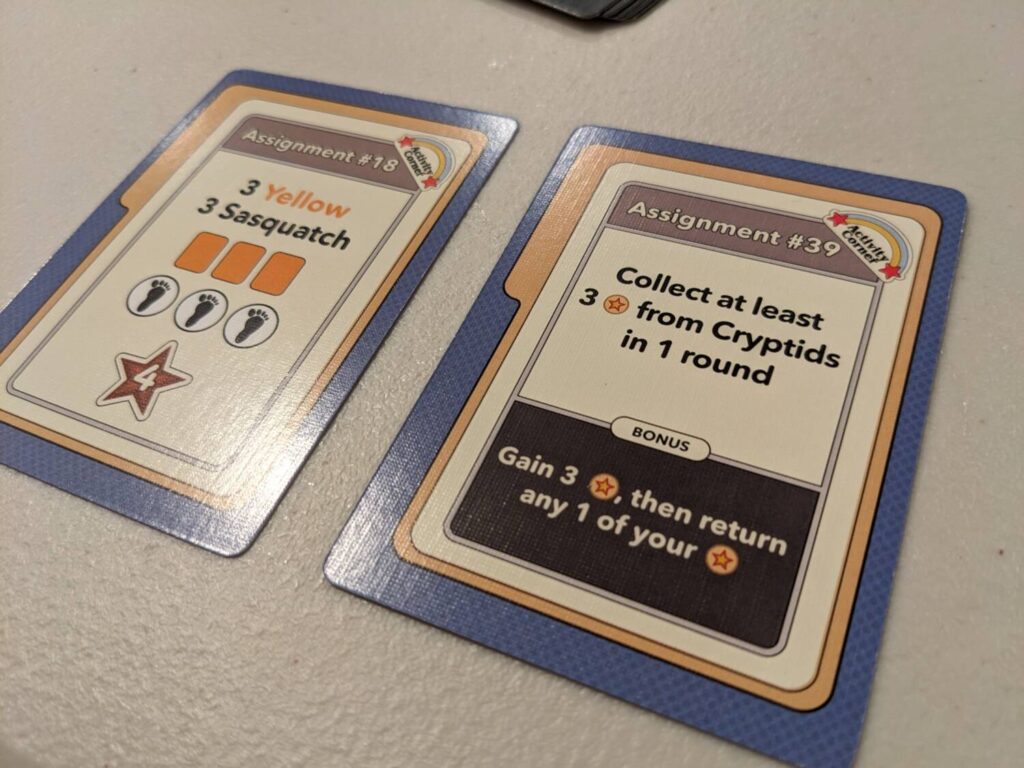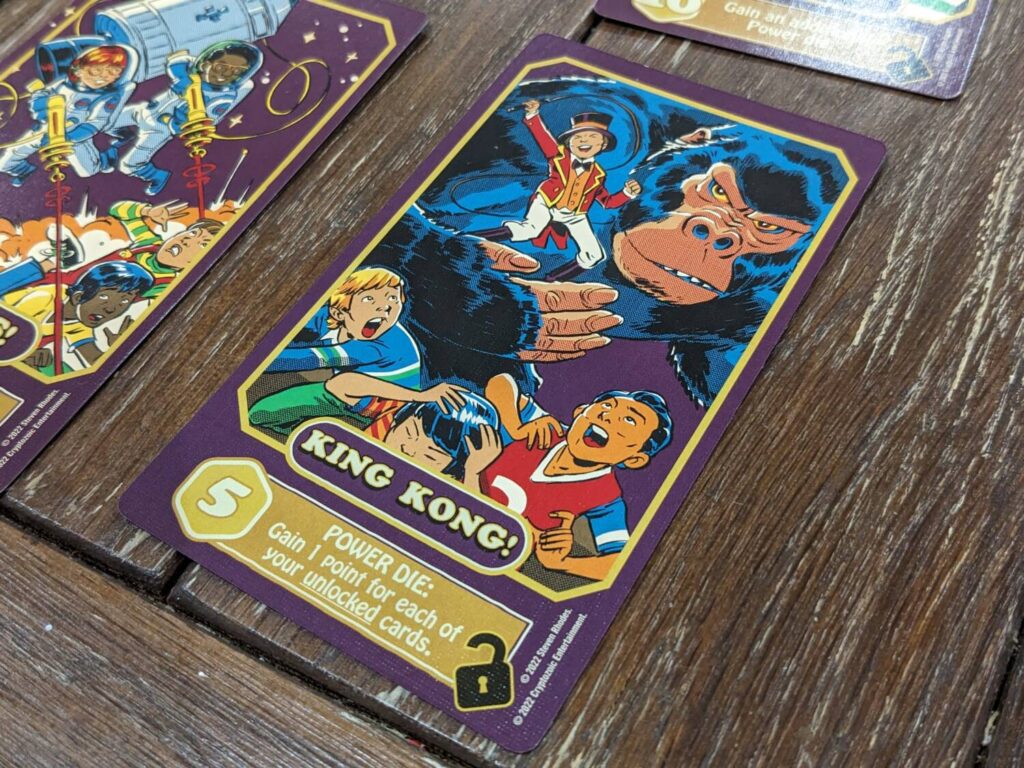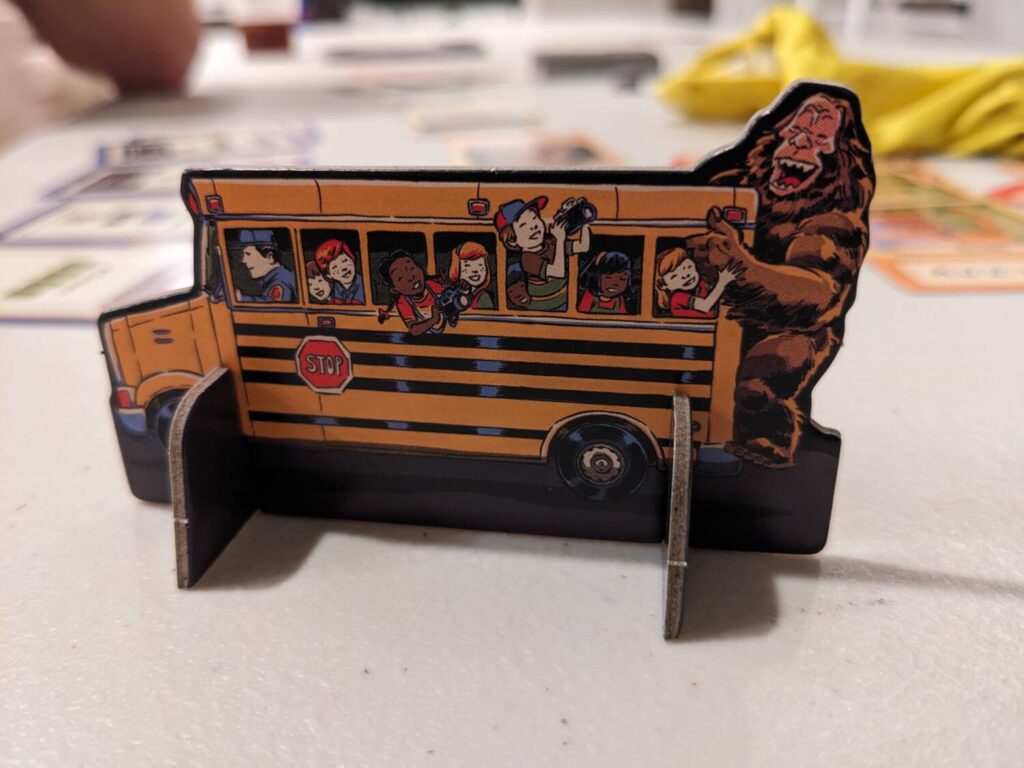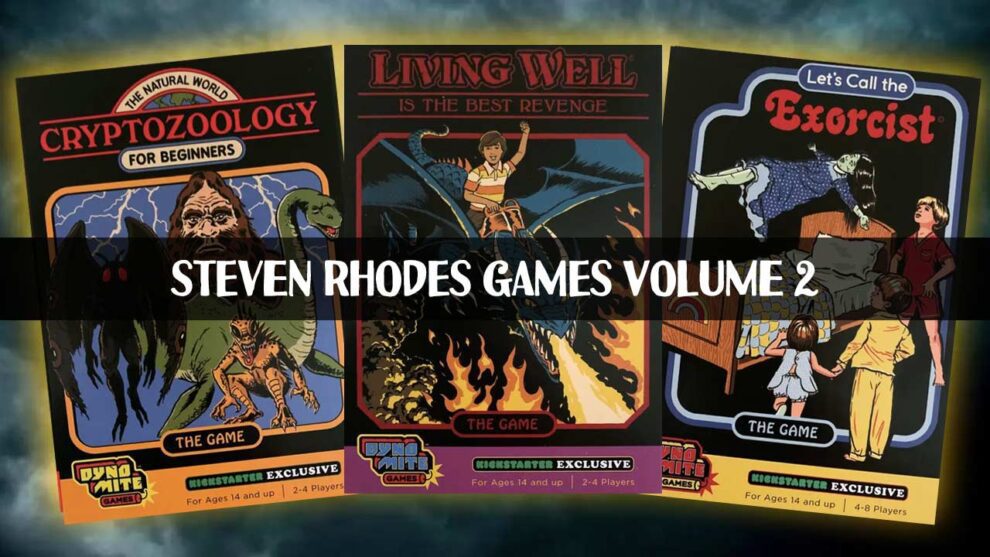Disclosure: Meeple Mountain received a free copy of this product in exchange for an honest, unbiased review. This review is not intended to be an endorsement.
Sometimes it is tough to get games to the table because you can’t forget a previous experience.
The first collection of games from publisher Cryptozoic in its collaboration with artist Steven Rhodes didn’t land well with me and the team of gamers in my respective groups. Save for Let’s Summon Demons, neither of the remaining games in Steven Rhodes Games Volume 1 made much of an impact.
Certainly, the artwork is the hook, and on that front, the first volume of games mostly delivered. Cryptozoic sent the second volume of games and it stared back at me from the shelves for many months. I just wasn’t sure I wanted to jump back in thatpool.
Unfortunately, Steven Rhodes Games Volume 2 isn’t much better than the first collection, but one of the games is the best of the six games under this banner.

Cryptozoology for Beginners
Cryptozoology for Beginners is a fairly straightforward set collection game that takes place over three rounds and uses a mix of public and private milestone cards to generate scoring for all players.
In each round, players draft eight cards from a deck of “cryptids”, things like Nessie, Sasquatch and the Chupacabra. Each card comes in one of four colors, and in one of seven different suits. After players get a set of eight cards, they draft one and pass the rest to the player to their left. Once each player ends up with eight cards, a round begins with players laying one of their cards faceup in their play area. This may or may not provide an opportunity to rotate a number of their active tableau cards to trigger an ability—score points, take more Cryptid cards, etc.
At any point during a turn, when a player meets the conditions on a face-up public milestone—known as Assignments—they immediately take that card for end-game scoring and possibly an instant bonus. In addition, players have private Assignment cards that can be revealed as soon as they are fulfilled.
Once all players have played their entire hand, the round ends and players draft new Cryptid cards. Those scoring tokens that are earned during the rounds? They are drawn from a face-down pool and range from 3-6 points each, similar to the scoring tokens in games like Deep Sea Adventure or one of my all-time favorites, Luxor.
In this way, you’ll have a sense of what each player’s score currently looks like: a mix of their public Assignment scores and a hidden scoring element, with those point tokens. (Of course, even if you don’t know what each player’s token total is, you know that more is worse for opponents!)
Rounds are snappy and gameplay moves quickly; I never had a game of Cryptozoology for Beginners last more than 30 minutes after the teach. Trying to draft the right kinds of cards is interesting because players are racing for both shared and dissimilar objectives, so it’s a crapshoot trying to figure out what is important to each player at the table.
Remember that you came for the artwork, because it’s what makes this game really shine. Some pictures of these Cryptids are absolutely hilarious and continue to mystify people who are not familiar with the work of Rhodes. The combinations of children and monsters in these pictures somehow always seem to make me laugh.
Cryptozoology for Beginners is a good time at the table. It is filler fare, with better production. Not everyone loved the hidden nature of the scoring tokens, but otherwise nothing here is objectionable. This game was better than everything in the first collection, which is really saying something.

Living Well is the Best Revenge
Taking some of the best elements of games like Space Base or Valeria: Card Kingdoms is the right move.
Similar to the best game from the first Steven Rhodes collection, Let’s Summon Demons, Living Well is the Best Revenge gives each player a set of the same 10 cards that serve as a skills and abilities tableau that has to be unlocked before opponents can do the same thing in a round. The action is started with all 10 of these cards in their locked positions; rolling a set of two player dice, the active player will unlock cards based on the total number of pips showing on the dice.
That means to begin a round, a roll of seven would allow for the active player to unlock their seven card, or their one, two, and four cards, or maybe their six and one cards. After this, normal turns begin; the active player rolls their two player dice plus a Power Die, which is the die that triggers any matching unlocked cards as well as any ability cards (numbered 7-9) once per turn. The #10 card grants a player their second Power Die, a fancy gold die with their player color on each pip.
Inactive players also roll their Power Die alongside the active player. If their roll matches one of the rolled dice from the active player and it also matches one of their unlocked abilities, they score a point. In this way, players are always invested in what the active player is doing, just like Space Base’s push to keep all players watching.
I got a few rules wrong in my first play, particularly around when activations for the active player take place and the importance of the gold Power Die. But once I got that down, I had some fun playing Living Well is the Best Revenge, particularly because of the round-end condition: a player is knocked out when they can’t unlock cards that match the total on their rolled player dice, or if one player unlocks all ten of their cards.
There’s a bit of strategy tied to the timing of the card unlocks. Flipping some of your lower-total cards early on gives you a chance to score more points, but doing that might also seal your doom if your die total comes up low in future turns. Flipping higher numbered cards grants more abilities with player dice totals, but limits any ability to score points in volume.
This game’s main problem is the same issue I had with the wordy title: it’s too long.
A full game of Living Well is the Best Revenge at four players nears an hour. That’s too long for a silly press-your-luck dice chucker, especially one that has some take-that elements that rubbed some players the wrong way. One card, the six card (locked side: Zero; unlocked side: Hero), robs an opponent of half their points, which can really keep points down across all players if even one person unlocks their six card.
After my first play, I house-ruled the entire game to be played over a single round. This was especially important in games with my kids; 15-20 minutes feels just right for something like this. Two rounds gives players a chance at more scoring, but that six card making an appearance in round two or three really hurts because someone is losing half of a 60, 70, or 80-point score.
Living Well is the Best Revenge was mostly a positive, but I had to change some of the base rules to get there. That artwork shines once again—the pictures on the front/locked side, and the changes they undergo when flipped to the unlocked side…oh my goodness, they are fantastic.

Let’s Call the Exorcist
Let’s Call the Exorcist is the only game on this list that I played just once…and that’s because this game is terrible.
As usual, the artwork on this game’s cards is excellent. However, that’s where the praise for this one ends.
A hidden role game featuring the good guys and “The Possessed”, Let’s Call the Exorcist is a 4-8 player game where all players draft a face-down role tile to begin play. Depending on player count (our game was a six-player experience), roughly two-thirds of the players are good and the remaining players are bad…but, I’m not sure the side matters because you can tell everyone what your role is and you can tell them what cards you have in your hand because table talk is allowed and encouraged.
Each round becomes a race. Armed with four cards that are a mix of fillers and artifacts, a “Seeker” selects one face-down card in front of any other player, who becomes the “Chosen.” The flipped card has text that must be followed, and whenever the round’s threshold for artifact cards has been hit, one side wins and each player on the winning side gets two points. For example, if both of the possessed artifacts are revealed in a six-player game, the possessed side wins.
Between rounds, roles are shuffled and redrawn…lather, rinse, repeat. When a single player gets to seven points, they win, unless multiple players reach seven points in the same round, then there’s a silly standoff that is even more random than the base game rules. (Unluckily for us, we found this out…and it took three rounds of these shenanigans to declare a winner. Or maybe “winner.”)
Let’s Call the Exorcist was pretty bad. We played this in our review group on a night with other party games, so the mood was ripe for this kind of experience. But nothing interesting ever happened during our 20-minute game. To the game’s credit, you can scale the winning point threshold up or down depending on player preference, so we had two players reach five points after the first round and collectively decided that the first round was also the last.

So, the Steven Rhodes Games??
I can’t speak to the other games in the Cryptozoic catalog, but in terms of the two Steven Rhodes game collections, they have featured just as many misses as hits. More importantly, none of the six games was a home run across the wide range of players who sat with me to try the games.
Save for that artwork, the production of each game feels a little cheap. That’s not a killer on its own, in part because I love the price point for these games individually.
But after playing all six games, I will admit to feeling a bit disappointed. I wish the quality of play was as strong as the artwork is wacky. Many of the pictures on these cards are laugh-out-loud funny and most are so absurd. The gameplay elements deserved better.
If there was a single game across the two packages I would recommend, that is hands-down Cryptozoology for Beginners. Let’s Summon Demons (from the first volume) and Living Well is the Best Revenge weren’t bad, particularly when considering house rules.
While Cryptozoology for Beginners is just above average in the broader scheme of tabletop games, it is leaps and bounds better than most of the other five games in these collections. And this will give you a chance to howl at the art of one of my generation’s premier spooky illustrators.












I am not familiar with the artist. The art you show here seems good; good art can raise a good game into the great… but it cannot be the only good thing going on. In other words: good art doth not a good game make.
So yea… I might look up the artist. I might keep an eye on them. But no, not going to be gathering these up anytime soon.
Thanks for a great review!